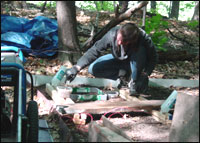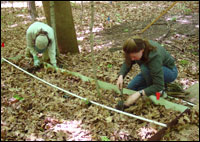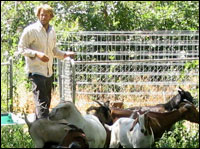Andy Holdsworth is a PhD candidate in conservation biology at the University of Minnesota. He studies the ecological effects and conservation implications of nonnative earthworms in Minnesota and Wisconsin.

Tuesday, 2 Sep 2003
MINNEAPOLIS, Minn.
There is a blurry line between work and play in my life. My wife, Hillary, learned this lesson for the Nth time this Labor Day weekend. She agreed to help me with one day of field research in exchange for a day of unscheduled canoeing and a day visiting a friend at a cabin in northern Wisconsin. As agreed, after six hours (less than a day!) of counting bunches of sedges (grass-like plants) in my research plots, we gleefully headed off to play in the Porcupine Lake Wilderness Area of the Chequamegon National Forest in northern Wisconsin. We portaged Moxie (our canoe) a half mile and slipped onto the lake for a leisurely afternoon paddle. With Hillary napping in the bow and me gazing at the wheeling and courting dragonflies, leisure seemed to have set in very nicely. Then I suggested we paddle to the shore and go for a little hike along a tributary stream …
We sauntered along admiring the pretty forest. Within five minutes, however, I couldn’t resist the urge to start scraping at the dead leaves on the ground. I had seen a distinctive lumpiness in the layer of leaves. I grabbed one of these lumps and below it I found what I expected: the burrow of Lumbricus terrestris, the earthworm that we all know as the “nightcrawler.” A foot away I found another and another and they continued for half a mile along the stream. Chatting with Hillary about her dreams of traveling to Cuba, I thought my earthworm curiosity was satisfied until I walked about 200 yards away from the stream and found “the leading edge.” “Hillary, we can go to Cuba if we find the rest of this leading edge.”

Earthworm Andy.
On the stream side of the edge, the layer of leaves was very thin and the ground was very hard underfoot, like pavement. Once we crossed over the leading edge the ground was like walking on a cushion with a thick covering of dead leaves. What made the difference? Earthworms. Apparently, fishermen dumped their leftover bait worms beside the stream and they spread about 200 yards into the forest. Across the leading edge there were no earthworms. I dispatched Hillary to confirm there were no earthworms further in the forest while I whipped out my GPS unit to map this leading edge. Wow, cool isn’t it? Okay, what other response would you expect from a guy whose friends call him “worm boy” or “earthworm Andy”? What is the big deal?
The leading edge we found was made by several species of nonnative earthworms. In fact, all of these earthworms are from Europe. Until European settlement of Minnesota and Wisconsin (and most of the northern edge of the United States), there were no earthworms working the soil. Yup, the last glaciation that ended about 11,000 years ago wiped out any earthworms that were in this region. For thousands of years, the forests and grasslands of this region developed without the influence of earthworms. When European settlers brought their fruit trees and other plants to the New Country, they inadvertently brought their Old Country earthworms. The use of earthworms as fishing bait has further scattered nonnative earthworms across the landscape. Until about 30 years ago, nobody thought anything of this.
Another graduate student in my lab has started studying these leading edges of earthworm invasion. She has found that the invasion of nonnative earthworms reduces the number of understory plant species by half and significantly reduces the cover of these plants, leaving mostly sedges and Jack-in-the-pulpit (check out photos and more info). This change results in the complete loss of the duff layer, or the partially decomposed leaf fragments (see photos of this, too). Without earthworms to incorporate this thick leaf mulch into the topsoil, forest herbs and tree seedlings rooted themselves in the duff layer. When earthworms invaded, the plants were essentially uprooted. (To learn more about these and many other changes caused by nonnative earthworms, visit the Minnesota Worm Watch website.)
But how will forests adjust to the invasion of “nature’s plow”? Which plant populations will recover and why? How will nonnative earthworms affect the productivity of northern hardwood forests? What are the implications of nonnative earthworms for forest conservation efforts? Many forest managers are asking these questions. I hope my PhD research provides useful answers.
Now it is back to the nitty-gritty of research work. It’s time to pick up my field equipment and field assistant, and head out to harvest samples from a field experiment. The work and play in the Porcupine Lake Wilderness Area seems so far away.
Wednesday, 3 Sep 2003
MINNEAPOLIS, Minn.
I woke up half-paralyzed by all of the things I could do with my day. This is all too common. It may become more common because last week I successfully passed my oral preliminary exams — two hours of interrogation by four professors. Fun! With that exam and my coursework behind me, I am free to focus on research. This is a great change, but it comes with a lot of time to structure. Even with today’s scheduled plant census at a suburban forest site, I am always scheming for ways to fit more in the day.
And there is good reason to fit more in my day. I recently estimated that I have five more weeks of intensive fieldwork this fall and more than 850 hours of lab work to do before next spring. I have been incredibly lucky to have a lab assistant help me identify and measure thousands and thousands of earthworms, sort and weigh leaf litter samples, conduct soil analyses, and enter reams and reams of data into the computer. However, as our research funding from the National Science Foundation and private contributions to my advisor’s Center for Hardwood Ecology run low, I will be doing much of this winter’s lab work myself. And then there is all of the data analysis and outreach to organizations and agencies interested in my results. After three intense years of fieldwork and increasing interest in the work, I am especially excited about starting this phase. Meanwhile, the summer field season is coming to a close as the Minnesota temperatures finally drop into the 50s at night and the leaves start falling.
Time to focus on today’s fieldwork in a suburban old-growth forest remnant, the Wood-Rill Scientific and Natural Area. How much biodiversity can urban and suburban nature reserves really preserve? As we struggle to find successful ways to coexist with a diversity of native species in an increasingly urbanized and suburbanized world, this question continues to gain relevance. Wood-Rill is a beautiful forest of stately trees, some of which are about 400 years old. However, it has virtually no plants growing on its forest floor. As it used to have them, what happened? The three major actors we suspect are deer, nonnative earthworms, and other effects of fragmentation. Urban and suburban reserves such as Wood-Rill are typically small fragments that are affected by what happens around them as much as what happens in them.
In the last several decades, deer populations have skyrocketed in the region (and the eastern United States in general). There are many reasons for this including the lack of natural predators and limited hunting of deer by humans and the residential “habitats” that suit deer so well. In these settings, hungry deer can significantly reduce the populations of herbs growing in forest fragments. Urban and suburban reserves are also susceptible to nonnative invasive species escaping from people’s yards. Finally, because these areas are fragments, it can be very difficult for some native plant species to recolonize an area that has suffered from such “disturbances” as high levels of deer browsing or an invasion of nonnative earthworms.

The deer fence at Wood-Rill Scientific and Natural Area.
All summer I’ve been driving to various forest reserves in the Twin Cities area trying to sort out how deer, earthworms, and other actors could be affecting these forests’ present and future. How do I do this? One way is to exclude deer and see how the forest plant community responds. Seven years ago a generous neighboring landowner at Wood-Rill contributed funds to install two one-acre fences to keep the deer out. We installed plots inside and outside these exclosures to measure plant abundance and diversity with and without deer. Today I am heading out to conduct the late summer survey. As we had an incredible profusion of sugar maple seedlings in the spring survey and now an intense late summer drought, it will be very interesting to see what has happened.
Always attempting to pack more in the day, after my fieldwork I will be entering data and preparing for another plant census at Wood-Rill. This is part of a new field experiment that I informally call “electro-shock therapy for forests.” Join me tomorrow as I wrangle with the challenges of removing tens of thousands of nonnative earthworms from a forest.
Thursday, 4 Sep 2003
MINNEAPOLIS, Minn.
In my introductory conservation biology textbook, David Ehrenfeld, professor of biology at Rutgers University, advised conservation biology students like me to: “Minimize the logistic complexity of your research.” I have truly strayed from his advice.

Earthworm Andy inserts electrodes in preparation for earthworm shocking.
This morning I am scheming about ways to find volunteers to help me extract as many earthworms from the ground as possible. Here is my version of research logistic complexity: find a large crew of willing helpers to dig 250 yards of two-foot-deep trenches by hand, bury large sheets of metal to form an underground wall in these trenches, plant 1,200 plants in these plots, haul a 4,000-watt generator a quarter-mile into the forest, build large arrays of metal electrodes, insert these into the plots, turn on the generator, collect every earthworm that comes to the surface, maintain a steady supply of volunteers to help for 10 days of worm “shocking.” Repeat in the fall, the spring, and the fall again. And remember the golden rule: don’t electrocute anybody.
I have to admit, part of me likes the logistics of research. I like working with volunteers. In fact, I just decided to recruit volunteers from among students I teach at the Twin Cities Environmental High School. I like building various contraptions. Logistically complex it is. But at least I have heeded one of Ehrenfeld’s points: “Include the participation and wisdom of the local community.”

A dedicated volunteer collects earthworms as they emerge from the shocked ground.
Shock worms from the ground? Why?! My plant census yesterday at Wood-Rill Scientific and Natural Area showed what we have noticed for six years. Even when we have completely excluded deer from parts of the forest, the understory plant community has recovered minimally. Could invasive nonnative earthworms be preventing native plant recovery? Remember, as I discussed on Tuesday, until 100 years ago (or less) there were absolutely no earthworms in this forest. It went from zero worms per acre to more than 1.5 million per acre! They have massively altered the structure and other properties of the soil. We know that they can dramatically reduce native plant density and diversity as they invade a previously worm-free area (check out a diagram for more info). But can we reverse these effects if we remove them from an area? So that is what I am doing — removing up to 60,000 earthworms from half of the plots and comparing plant growth in these plots to ones where we did not remove the earthworms.

Volunteer plantings help determine how earthworms affect forest growth.
Thankfully for me, I can always get volunteers to come out for worm shocking. It is amazing to see the ground seethe with worms as they escape the small electrical current. This technique has broader appeal too. Last spring the evening TV news even covered the work. This attention helps to spread awareness about an important issue affecting our forests. And don’t worry — the worms are not hurt by this. We pick each one up and release them under the fruit trees on campus.
It was a late night last night. I organized my data from yesterday’s plant census, prepared data sheets for today’s census, and responded to some emails about a symposium that several of us are trying to organize. Should it be approved by the Ecological Society of America, the symposium will convene many academic researchers who study the ecological effects of nonnative earthworms in ecosystems around the world.
Four years ago I would never have expected to be so consumed by this research topic. But I think it illustrates many interesting challenges for habitat conservation and conservation education. I am looking forward to working on that component of my work tomorrow. For now, I am off to the field once again to monitor plant growth in the worm-shocking plots.
Friday, 5 Sep 2003
MINNEAPOLIS, Minn.
Field research can be terribly monotonous. “Wild, 3.5, 1, 0, ER, G. Violet, 1, 1, 0, S. Sugar, DL. Virginia, 1.5, 0, 1, H1.” That’s the sound of my assistant and I monitoring the status of 1,200 plants in the worm electro-shocking experiment at Wood-Rill. We droned on for six hours of this bizarre field chanting. Thankfully, the fierce Minnesota mosquitoes have died down. Despite the mind-numbing data collection, as we walk homewards through the forest I marvel at the beauty of this remnant of Minnesota’s “Big Woods” and remember how lucky I am to have the opportunity to decipher some of its stories.
But where and to whom do we tell these stories? Amidst today’s tasks of reviewing a friend’s manuscript, filing research expense reports, checking in with my advisor, and continuing ceaseless data entry, my thoughts turn to outreach. Nonnative, invasive species are ranked as the second most significant menace to threatened and endangered species. They are considered major threats to global biodiversity, along with such better-known problems as climate and land-use changes. However, public awareness of invasive species and policies to prevent their spread is very limited. With ballooning global trade and travel, the challenges only heighten. When it comes to invasive species in the soil, like various species of earthworms, we really have a long way to go.

Download a larger version of the poster.
Minnesota is taking a leading role, though. As a result of land managers’ concerns, research results, and a risk assessment of nonnative earthworms, the Minnesota Department of Natural Resources (DNR) and the Minnesota Native Plant Society produced an outreach campaign to educate the fishing public about the ecological impacts of nonnative earthworms and encourage people to dump their unwanted bait in the trash, not in the woods. A DNR video news release showing the impact of invasive earthworms at our research sites was distributed throughout the state. More than 1,000 “Contain Those Crawlers” posters went to bait shops.
This educational campaign is a great start and I want to do all I can to help spread its message. Today I contacted a Chequamegon National Forest intern about distributing the posters there. I drafted a list of nonprofit groups, agencies, and publications to contact about my current and future research results. As a researcher, I always hope that the questions I have asked and the way I have approached answering them will be as useful as possible to on-the-ground work. Conducting outreach myself is an important reality check on the connection between research and applied conservation and management. As my coursework is finished and two of my three major research projects wind down, I look forward to exploring this connection even more.



